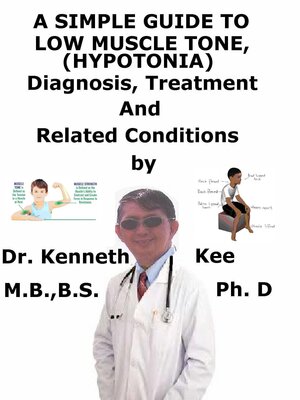A Simple Guide to Low Muscle Tone (Hypotonia), Diagnosis, Treatment and Related Conditions
ebook
By Kenneth Kee

Sign up to save your library
With an OverDrive account, you can save your favorite libraries for at-a-glance information about availability. Find out more about OverDrive accounts.
Find this title in Libby, the library reading app by OverDrive.



Search for a digital library with this title
Title found at these libraries:
| Library Name | Distance |
|---|---|
| Loading... |
This book describes Low Muscle Tone (Hypotonia), Diagnosis and Treatment and Related Diseases
Low muscle tone is termed hypotonia and "floppy muscle syndrome.".
People diagnosed with low muscle tone do not show resistance when joints in their body move.
Muscle tone is the quantity of resistance (tension) to the movement the muscles maintain at rest.
If a person relaxes the left arm and uses the right arm to pinch the bicep, the resistance the person feels is the muscle tone.
For people diagnosed with hypotonia, pinching the bicep would feel soft without any resistance.
Muscle tone is the body's reaction to force and permits the person to maintain the posture to sit and use the reflexes such as moving the arms and legs, and control the function of the body's organs.
Muscle weakness and low muscle tone are not the same.
Muscle weakness is insufficient strength in the muscles and is a symptom linked with hypotonia.
If the person has low muscle tone, the arms and legs appear floppy, similar to a rag doll.
The baby with low muscle tone might have difficulty sitting upright, holding their head up and bending their elbows and knees.
Doctors can diagnose the hypotonia in the first few minutes of life.
They do routine examinations of newborns' muscle tone at 1 minute and 5 minutes after birth.
Occasionally hypotonia shows up a bit later but it will normally be detected by 6 months of age.
Low muscle tone can also affect adults as in adult spinal muscle atrophy.
Hypotonia is the most frequent feature that affects a newborn's motor skills.
Low muscle tone, as a symptom, is not a disability but the underlying diagnosis could be a disability since it can affect how a person performs their daily tasks.
Infantile hypotonia can happen for no clear reason and is termed benign congenital hypotonia.
Hypotonia does not affect intellectual abilities.
The main causes are:
Brain injury or problems with how the baby's brain formed during fetal development.
Disorders affecting how nerves communicate with muscles.
Disorders affecting muscles.
Disorders affecting nerves that communicate with muscles.
Infection.
Lack of oxygen before the baby is born or immediately after.
Children diagnosed with hypotonia may have delayed development milestones affecting their motor skills such as:
Sitting upright.
Crawling.
Walking.
Saying first words.
Feeding on their own.
Other symptoms are:
Muscle feeling extremely soft
Difficulty extending the limb beyond what is normal
Shallow breathing
Under-active gag reflex
If the doctors suspects hypotonia, they will do further tests:
Genetic test to identify any genetic abnormalities causing symptoms
Imaging tests to observe the brain, spinal cord and the muscles such as an MRI or CT scan.
Electromyograms to measure how muscles and nerves function
Electroencephalogram to measure electrical activity in the brain
Spinal tap to measure the pressure inside the spine and test a sample of the spinal cord fluid
Muscle biopsy, when the doctor gets a sample of the patient's weak muscle tissue to study under a microscope
Blood tests to detect infections, metabolic diseases causing hypotonia
The doctor will begin treating the underlying disorder, followed by symptomatic treatment to correct symptoms:
Physical and occupational therapy to improve motor skills.
Speech-language therapy to correct difficulties in speaking, swallowing and breathing.
Sensory stimulation therapy to improve sensory function.
Medicines for...







